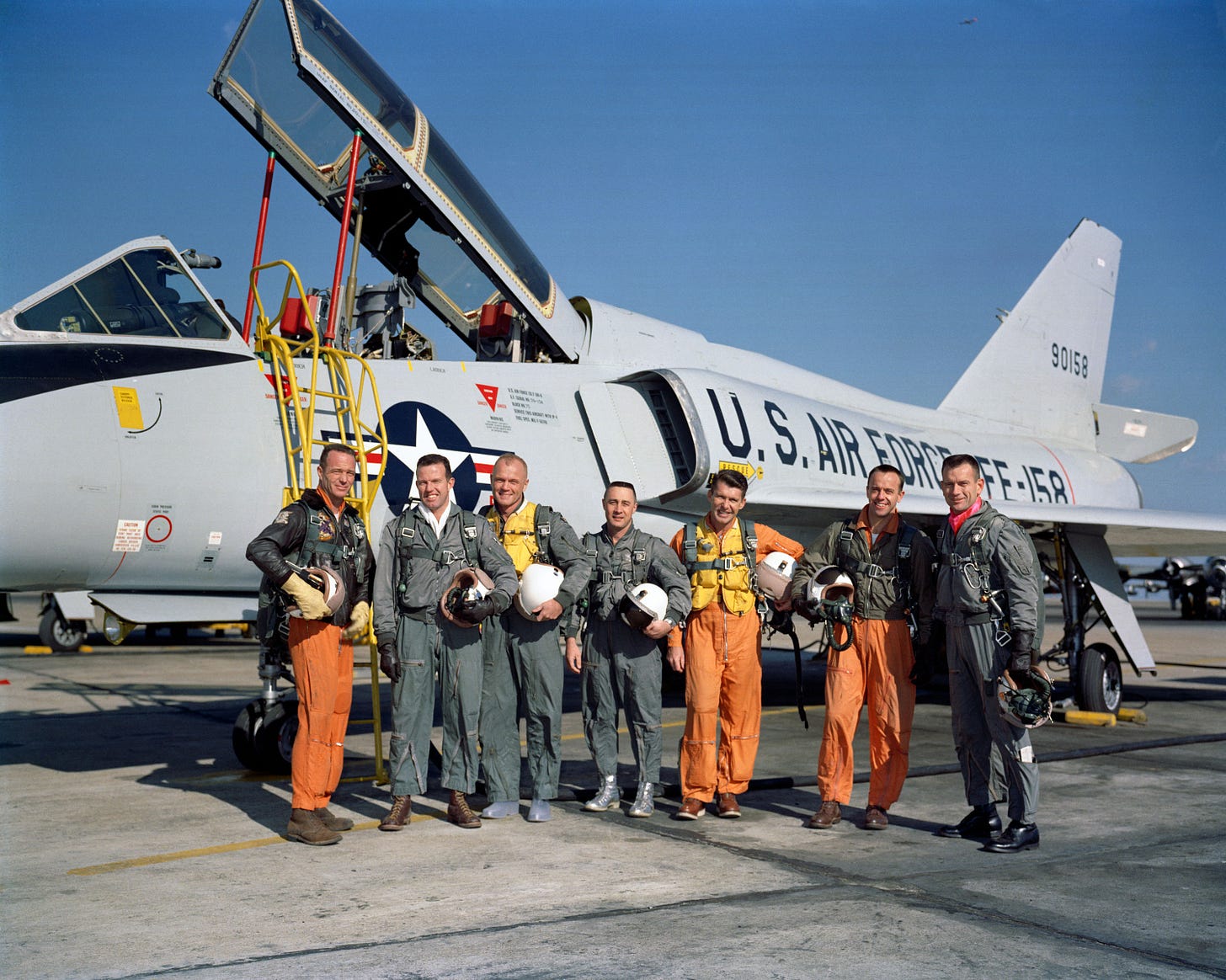TDIH: The Mercury Seven
An elite group, selected only after an arduous application process. Applicant Pete Conrad would later say that he felt like a “lab rat.”
On this day in 1959, NASA announces the names of its first astronauts. The “Mercury Seven” were an elite group, selected only after an arduous application process.
Or maybe the word “arduous” is too kind. Applicant Pete Conrad would later say that he felt like a “lab rat.”
The selection process for astronauts began in December 1958 when NASA solicited and received applications from 508 military test pilots. Candidates’ service records, educational history, and total flying time helped NASA narrow the list down to 110 men. Interviews and written tests narrowed the applicant pool down yet again, this time to 32 pilots.
These men would spend the next few weeks enduring grueling physical tests, first in New Mexico, then in Ohio. The idea was to test their physical and mental endurance to see if they could handle the stress of space. But many felt that the tests went too far.
Candidate Jim Lovell would call his week in Albuquerque a “nightmare week,” while another candidate concluded that it was “an embarrassment, a degrading experience . . . sick doctors working on well patients.”
“In submitting to these whole-body violations,” Lovell later said, “the candidate astronauts would have their livers injected with dye, their inner ears filled with cold water, their muscles punctured by electrified needles, their intestines filled with radioactive barium, their prostate glands squeezed, their sinuses probed, their stomachs pumped, their blood drawn, their scalps and chests plastered with electrodes, and their bowels evacuated by diagnostic enemas . . . .”
The doctors likely had more reasons for their tests than the potential astronauts knew, but the doctors didn’t feel the need to explain themselves, either. It added to the candidates’ frustration. “Any questions like ‘What’s that for?’ were met by grunts,” candidate Gordon Cooper later said.
Would you believe that was just the first phase of the process? The next phase, in Ohio, tested physical endurance and psychological well-being.
Candidate John Tierney described the “torture machines” that followed.
“We would put on flight suits with a hole in the bottom,” he wrote, “and sit on a chair in an oven with a rectal thermistor inserted as the scientists cracked the kiln up to 130 degrees. Later, we sat in an airplane simulator as the operators on the outside tilted and shook the mockup violently. Inside, we were blindfolded, and had to use our other senses to keep the test craft level . . . .”
Psychologists and scientists hovered everywhere, taking notes as if the candidates were specimens in a lab.
Not everyone went along with it all the time, as when Conrad retorted to a psychologist that he couldn’t tell what was on a blank white card because “you’ve got it upside down.” Other men, though, simply endured. “Not that I liked any particular bodily examination or psychological test,” Tom Hayward said, “[but] the very compliment that I might have a chance at being chosen as one of the original astronauts made all this ‘part of the course.’”
In the end, 31 men passed the test. NASA officials would ultimately narrow the list down to 7. They’d only intended to select 6 pilots, but they found themselves stuck between two candidates at the end and took both.
The Mercury Seven were introduced to the country at a press conference on April 9, 1959: Scott Carpenter, Gordon Cooper, John Glenn, Gus Grissom, Wally Schirra, Alan Shepard, and Deke Slayton.
Members of the Mercury Seven would travel in all of NASA’s subsequent space programs, starting with Mercury and ending with John Glenn’s 1998 trip aboard the Space Shuttle.
Naturally, those are stories for another day.
Sources can always be found on my website, here.



What a remarkable time in America. I remember the introduction of the Mercury seven to the world. It was an exciting time. It was during the cold war and we were in a race with the Soviet Union. The world knew nothing about sending a person into space, nor what that person would be subjected to in weightlessnes, or in reentry.
The seven original astronauts had to be beyond brave as they, not unlike those who were sworn into the military (which they were), promised to sacrifice their life in the interest of the United States of America, if necessary.
I remember each and every launch as astronauts were strapped to the rocket and sent into space. Exhilarating for sure and so dangerous and, we owe much to each of those young men. Thank you Tara.
Stories and information I never heard before. Very interesting. A testimony to their drive to be "Star" in America's Space Program! Thank you, Tara Ross.